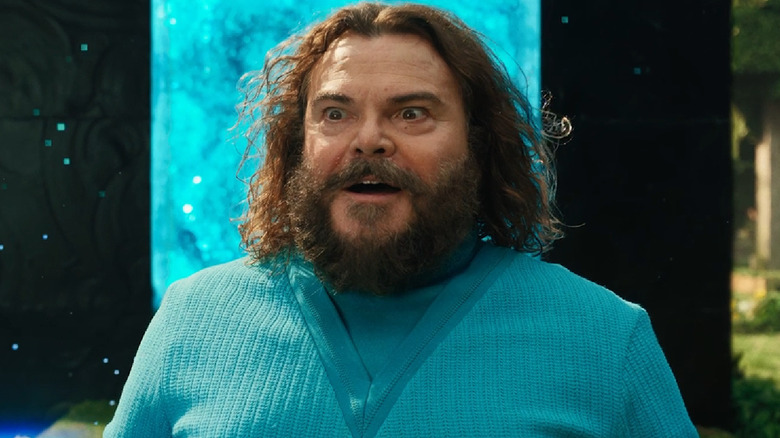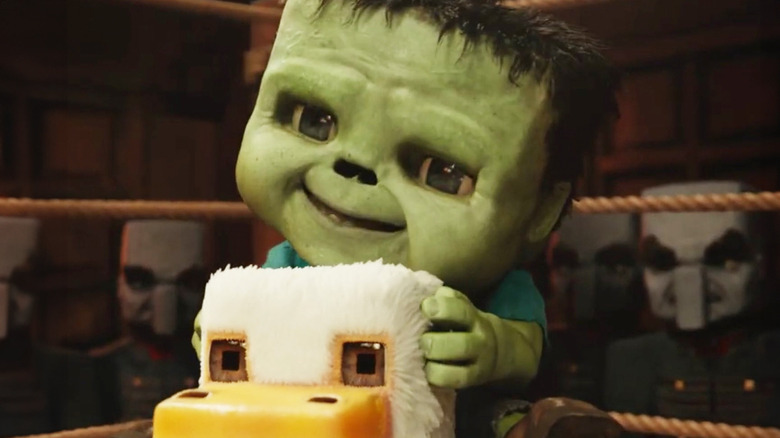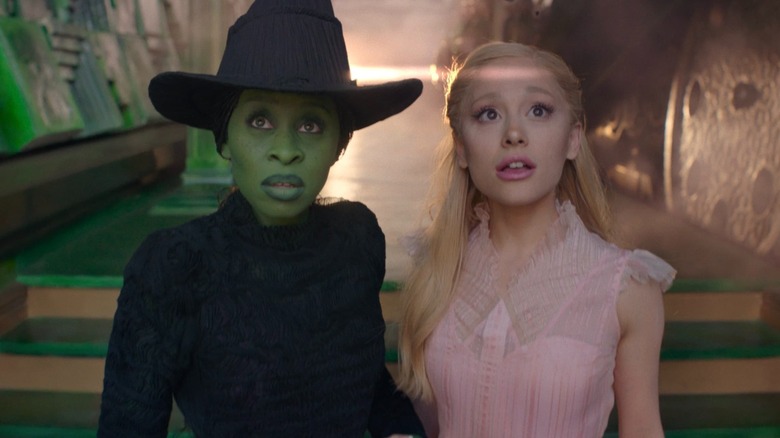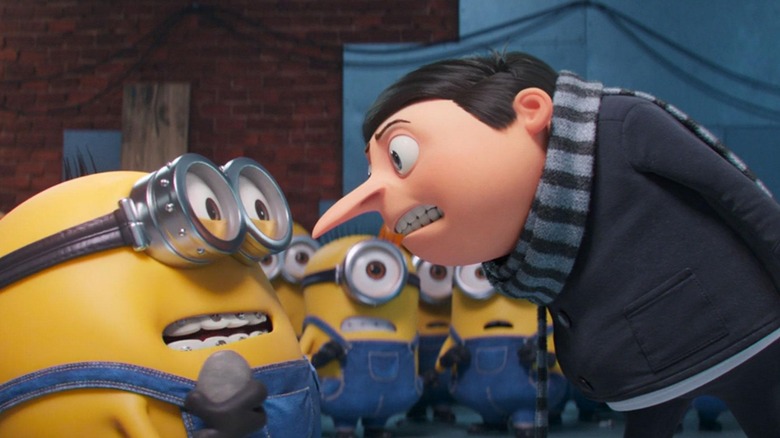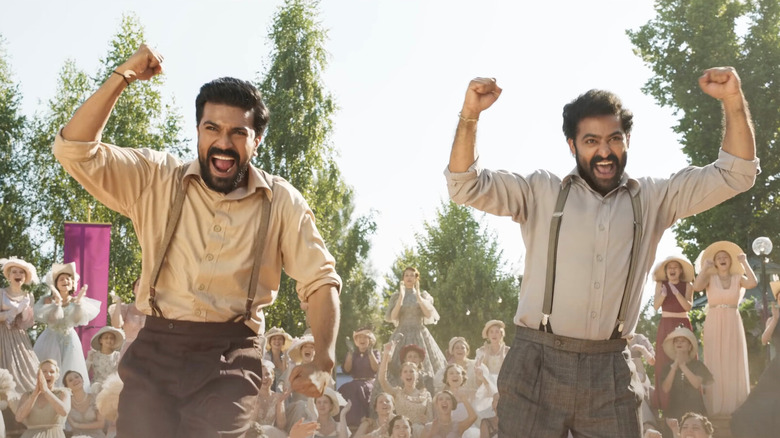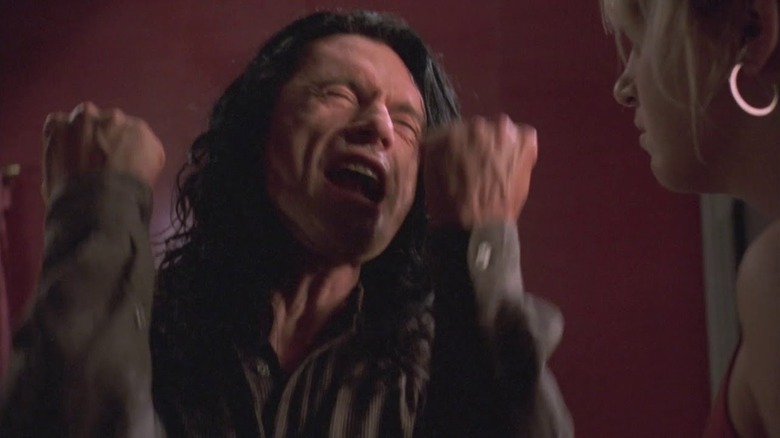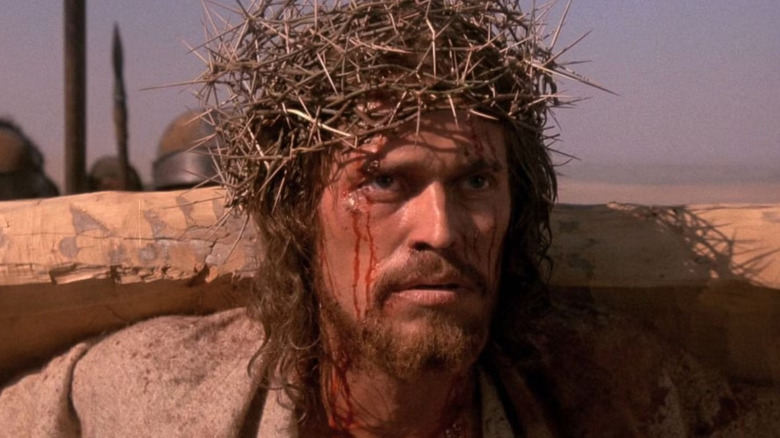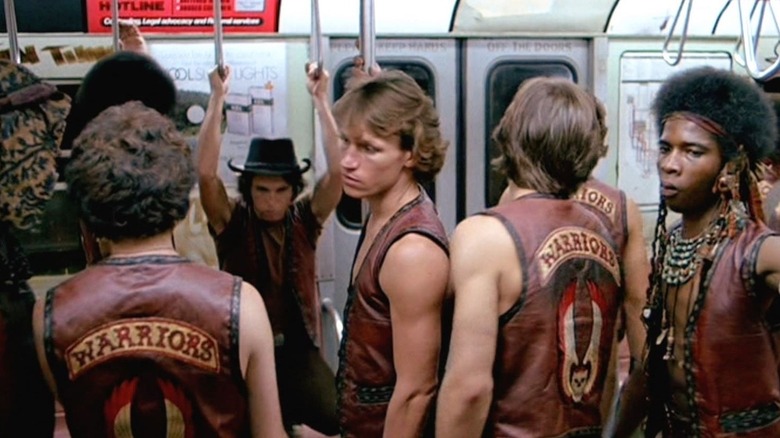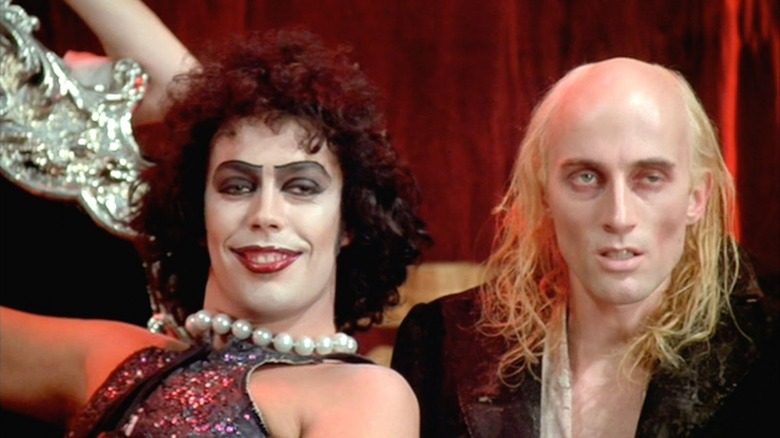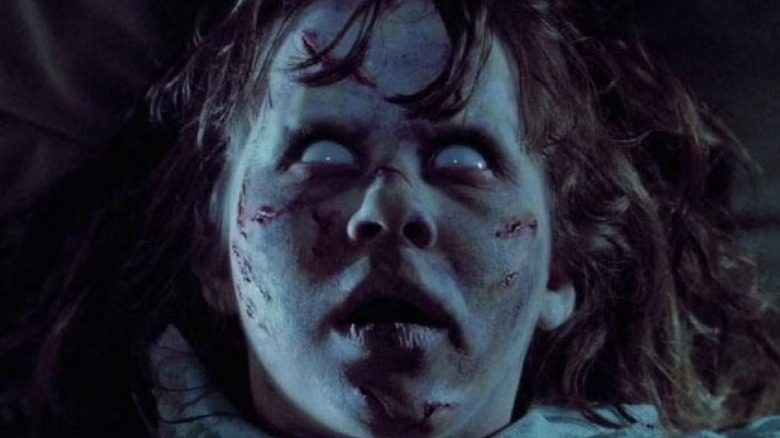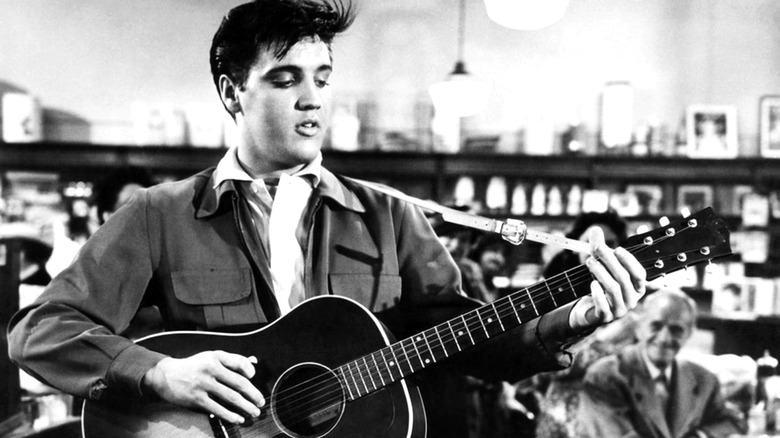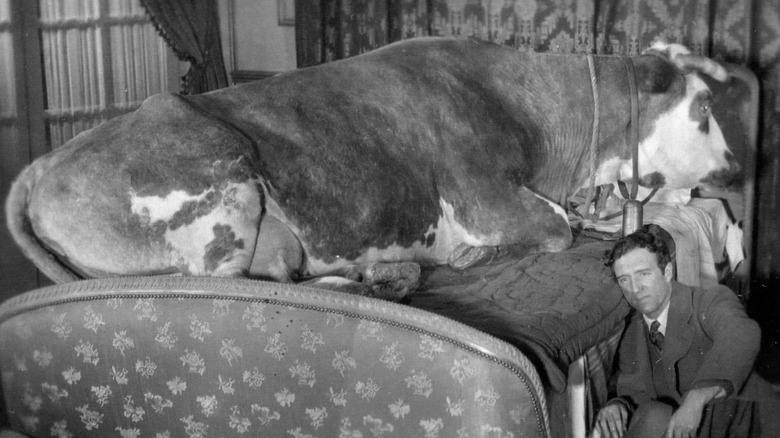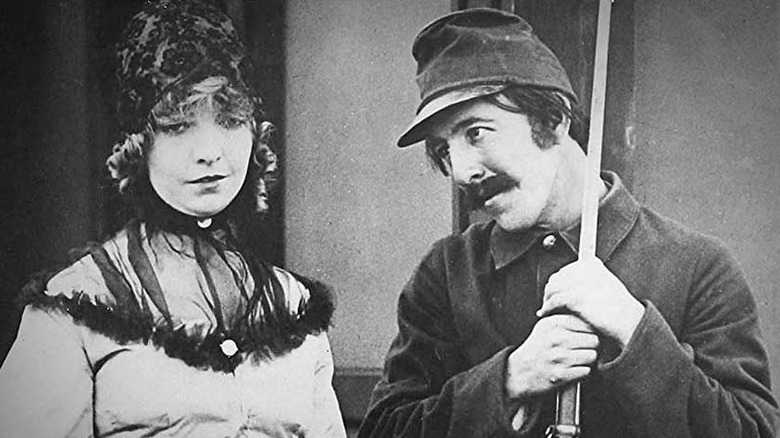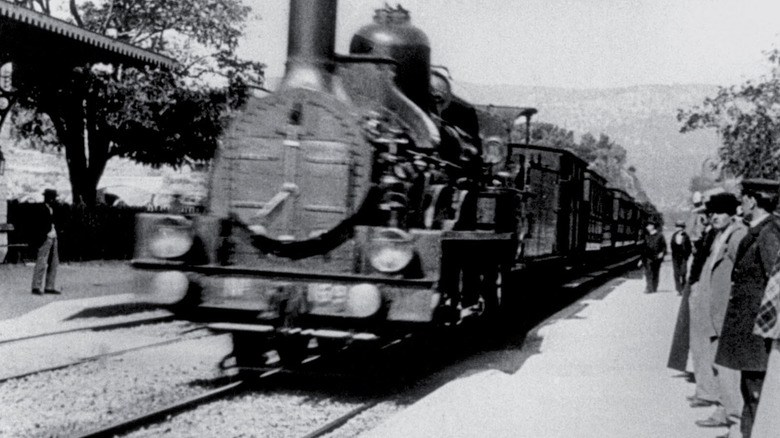Films That Sparked Chaos In Cinemas
Part of the fun of going to the movie theater is to see films with an enthusiastic audience. The crowd laughs at the funny parts, screams at the scary parts, and cheers at the awesome parts. Then there are times when the audience gets extra passionate, whether they love the movies they're watching or they hate them, and the normal rules of theatre etiquette get tossed in the garbage. Sometimes these moments of movie theater chaos become viral trends or even socially approved exceptions to the norm. Other times, things get outright dangerous, with movies used as a pretext for acts of violence.
From Gen Alpha meme fests that became the bane of theater employees to some of the first moving images that might have sent your great-great-great-grandparents running for the hills, let's take a look at some of the most infamous movie screenings throughout history that, for better or for worse, went totally out of control.
A Minecraft Movie
Even those who have avoided seeing "A Minecraft Movie" have probably seen many videos of young moviegoers losing all self-control during the scene where Steve (Jack Black) says the phrase "Chicken jockey!" to describe a baby zombie riding a chicken. That so many people are filming these in-theater reactions is already breaking theater rules to begin with, and it only gets weirder with some of the wild reactions of "Minecraft" fans shown in those videos.
It's been common for audience members to throw popcorn at the screen during the "chicken jockey" scene. But police have also been called to kick kids out for getting too rowdy, and someone snuck a live chicken into a screening in Provo, Utah. Meanwhile, in Warwick, Rhode Island, four teenagers allegedly attacked adults who told them to quiet down with knives.
That latter incident aside, the non-criminal reactions to "chicken jockey" have mostly amused director Jared Hess. Jack Black introduced one screening with a warning against throwing popcorn, and theaters have added pre-show disclaimers issuing similar warnings. Regal Cinemas locations hosted designated "Chicken Jockey" screenings in their 4DX screens on April 20, perhaps in the hope that if chaos can't be avoided, it can be contained to specific showtimes.
Wicked
Specially designated sing-along screenings for musicals have long been a thing, either for re-releases of classics or to give a second box office wind to movies reaching the end of their theatrical runs. "Wicked (Part 1)" had such screenings planned in advance for Christmas 2024, but even before then, an awful lot of normal screenings turned into unofficial sing-alongs.
This was not fun for people wanting to hear Cynthia Erivo and Arianna Grande's beautiful voices beneath a sea of terrible karaoke, and AMC Theatres officially banned singing at regular "Wicked" screenings. Dwayne Johnson defending the singing moviegoers, hoping they'd also sing along with "Moana 2" — not that there was much threat of that, with the songs in "Moana 2" not being the least bit memorable.
"Wicked" also sparked some controversy over the trend of photographing and filming scenes from the film to post on social media. This trend both violates federal piracy laws and general movie theater rules, but studies show that 20% of teenagers are now using phones in movie theaters.
Minions: The Rise of Gru
Upon its release in 2022, "Minions: The Rise of Gru" smashed box office records in part thanks to surprisingly strong ticket sales from meme-obsessed teenagers. Minion memes used to be the domain of Boomers on Facebook, but Zoomers led the "Gentleminions" phenomenon of going to the movies in fancy suits to ironically enjoy the then-latest Illumination cartoon.
If it were just a strange fashion trend, "Gentleminions" would have been hilarious — and the people at Universal certainly loved the extra money it made them. Unfortunately, some of the "Gentleminions" also gave movie theaters a preview of the type of inappropriate theater behavior that would come to a head with "chicken jockey" a few years later. TikToks showed screenings turning into mosh pits, some theaters reported property damage, and the film's target audience of families were disturbed by some of the teens' rowdiness. In the U.K., several cinemas banned unaccompanied suit-wearing youth from attending as a precaution.
RRR
In the debate over appropriate audience behavior, one argument made in favor of loosening theater rules is looking at different international cultural standards. Indian movie theaters, for example, are more relaxed about moviegoers talking, texting, or doing pretty much anything they want. Audiences around the world got a taste of the most positive version of the rowdy Indian moviegoing experience with the global release of "RRR."
Audiences could get loud at "RRR" screenings — but they were loud because they were so involved with the over-the-top action on screen. On top of the near constant cheering over the course of the three-hour epic, the Oscar-winning "Naatu Naatu" musical number prompted many crowds to start their own dance parties in the theater. Even in Japan, where silence is expected at the movies, "RRR" fans went all out for "screaming screenings" where they put together cosplays, yelled at the characters, and jammed along to the soundtrack with tambourines and noisemakers.
The Room
"The Room" barely had a normal theatrical release. Writer-director-producer-actor Tommy Wiseau self-distributed the "so bad, it's good" film in a few Los Angeles theaters in 2003, promoting it with a creepy billboard and pushing it for Oscar consideration. With "The Room" playing to nearly empty houses, the few who ended up buying tickets felt free to talk back at the screen "Mystery Science Theater 3000"-style — and when those people started dragging their friends to the movie, a cult was born.
"The Room" has since become a mainstay of the midnight movie world, with celebrity fans, YouTube reviews, Adult Swim April Fools airings, and actor Greg Sestero's tell-all memoir "The Disaster Artist" (co-written by Tom Bissell and adapted into a 2017 movie of the same name) further expanding its reach. With bad movie screenings at midnight, chaos is not only expected but encouraged. In addition to providing colorful commentary that makes fun of the movie's many flaws, fans will throw footballs around the theater when Johnny (Wiseau) does the same with his friends and toss spoons whenever that inexplicable framed photo of a spoon shows up.
The Last Temptation of Christ
Protests surrounding controversial movies are more likely to cause chaos outside movie theaters than inside them — after all, people boycotting a movie aren't buying tickets. However, the protests against Martin Scorsese's "The Last Temptation of Christ" — which was controversial for including a sequence in which Jesus Christ (Willem Dafoe) sees a Satanically-induced vision of himself starting a family with Mary Magdalene (Barbara Hershey) — weren't limited to just pickets and boycotts. Violence broke out in many theaters showing the movie in France, with screenings interrupted by assaults, tear gas, stink bombs, and one major arson attack.
On October 22, 1988, members of far-right religious groups firebombed the Saint-Michel cinema while it was playing the supposedly "blasphemous" movie. Thirteen people were injured in the attack, and the cinema closed for repairs for the next three years. Jean-Marie Cardinal Lustiger, the Archbishop of Paris, had previously condemned the film sight unseen, but also condemned the terroristic violence of the protesters, whom, he said, "don't behave as Christians but as enemies of Christ" (via The New York Times).
The Warriors
The gang war thriller "The Warriors" might be embraced as a campy and over-the-top cult favorite today, but in 1979, people were genuinely scared of it, in large part due to the real-life acts of gang violence that occurred at several theaters showing the movie. Two murders in California theaters and one murder in Boston directly following a screening led Paramount to temporarily halt advertising for the film, with the studio offering to pay for increased security at any theater that requested it.
Reflecting on the violence surrounding the film's release 35 years later, director Walter Hill told Esquire, "I think the reason why there were some violent incidents is really very simple: The movie was very popular with the street gangs, especially young men, a lot of whom had very strong feelings about each other. And suddenly they all went to the movies together! They looked across the aisle and there were the guys they didn't like, so there were a lot of incidents." He acknowledged the film's "rambunctious" nature might have played a part in heightening the tensions, but in all likelihood, the violence had more to do with the nature of the audience rather than the content of the movie itself — which wasn't even that violent.
The Rocky Horror Picture Show
The standard-bearer for midnight movie madness, "The Rocky Horror Picture Show" bombed in its initial 1975 release. But it's still playing in major cities and college towns today thanks to how its cult following turned midnight screenings into wild events, with screenings often selling out for Halloween and Pride Month in particular. You haven't truly seen "The Rocky Horror Picture Show" if you've only watched it on video or streaming, because the crazy theatrical experience is what makes it a legitimate classic.
At "Rocky Horror" showings, "virgins" (those who haven't seen the film) go through hazing rituals before the film starts. Any moment of silence in the campy musical is filled in by the audience shouting call-backs at the screen, while "shadow-casts" perform the action alongside the actors on-screen. Traditions involve bringing props and throwing them at the screen at specific times, "chicken jockey"-style: rice during the wedding scene, toast when Dr. Frank-N-Furter (Tim Curry) says "A toast," and playing cards during the lyrics "Cards for sorrow, cards for pain," among others. Gender-bending costumes and open displays of sexuality are encouraged — "Rocky Horror" fandom has historically served as an important refuge for the LGBTQ+ community.
The Exorcist
"This horror movie is so intense, it's making people physically sick!" has become such a common line of hype that it could warrant its own article. From the "Terrifier" gorefests reportedly making moviegoers throw up to mass fainting at the arthouse body horror film "Titane" to even stress-induced walkouts at the relatively tame ghost story "Presence," it would be easy for these sorts of reactions to dominate this list. Instead, we'll focus on the granddaddy of this whole phenomenon: "The Exorcist."
Any sort of extreme reaction you can image having to being frightened or disgusted by a horror movie, someone had it to William Friedkin's 1973 blockbuster. Preview audiences ran out of the theater screaming. Theaters had ambulances on call. There was vomiting, fainting, and seizures. One young lady fainted before the film even started. A man got carried out on a stretcher 20 minutes in. A woman allegedly had a miscarriage. Psychologists reported on "cinematic neurosis" triggered by the film.
And despite — or maybe because of — all this, everyone still wanted to see "The Exorcist," with the long lines outside theaters sometimes on the verge of rioting to get in. In the book "Laughing Screaming: Modern Hollywood Horror and Comedy," historian William Paul wrote of "The Exorcist," "There is no film that ever attracted so much commentary on the audience itself."
King Creole
Elvis Presley had a way of making both his fans and his haters go crazy for different reasons. Elvis wasn't in the building at the 1959 Mexico City premiere of the 1958 film "King Creole" — his fourth starring role, and the best Elvis movie, according to Looper — but the riot that accompanied the screening might as well have been a scene at one of his concerts. Local newspapers reported 600 teenagers breaking into the Américas Cinema without paying, with acts of vandalism and sexual violence reported and riot police called to the scene.
Anti-Elvis sentiment ran high in Mexico at the time. Gossip columnist Federico de León quoted the rock star as making anti-Mexican statements; it's since been alleged that these quotes were fabrications meant to punish Elvis for rejecting a performance request from a Mexican politician. Presley's dancing was deemed "feminine" and many in Mexico accused him of being gay. The fact the 1963 Elvis-goes-to-Mexico movie "Fun in Acapulco" was shot in Los Angeles has led some to believe Elvis was banned from visiting Mexico due to the riot – although he was instead restricted from leaving the United States due to Colonel Tom Parker's lack of a passport.
If you or anyone you know has been a victim of sexual assault, help is available. Visit the Rape, Abuse & Incest National Network website or contact RAINN's National Helpline at 1-800-656-HOPE (4673).
L'Age d'Or
Commissioned as a birthday gift for the wife of wealthy arts patron Vicomte de Noailles, "L'Age d'Or" was the second collaboration between director Luis Buñuel and surrealist artist Salvador Dali. Confused that their disturbing short film "Un Chien Andalou" somehow became popular with the bourgeoisie, Buñuel and Dali sought to make their second film even more shocking and provocative. They were perhaps too successful at that task for their own good, given "L'Age d'Or" ended up banned for 49 years.
This censorship came in the aftermath of a riot during a screening at the Studio 28 theatre on December 3, 1930. Offended by the film's sexual content and criticism of Christianity, members of far-right groups the League of Patriots and the Anti-Semitic League threw ink at the screen and stink-bombs at the audience, while also destroying surrealist art displayed in the lobby. Police confiscated the film prints, and "L'Age d'Or" wouldn't screen legally again until the Roxie Theater in San Francisco programmed it in 1979.
The Birth of a Nation
D.W. Griffith's 1915 feature "The Birth of a Nation" was the biggest box office hit of the silent era. It was also breathtakingly racist even by the standards of its time, bolstering the revival of the Ku Klux Klan and sparking increases in anti-Black hate crimes. It's hard to even find images from the film that can be comfortably displayed — it's that ugly. Naturally, emotions around the film were intense, and both fans and critics had some dramatic in-theater reactions during its initial run.
One man in Spartanburg, South Carolina was reportedly so moved by "The Birth of a Nation" that he pulled out a gun in the theater and shot at the screen to "save" Flora Cameron (Mae Marsh) from the freedman Gus (Walter Long — a white actor in blackface, of course). On the opposite side, anti-racist protesters disrupted a screening at the Liberty Theater in New York City by throwing eggs at the screen and giving speeches about how the film insulted African Americans, highlighting how particularly inappropriate it was to show on the anniversary of Abraham Lincoln's assassination.
L'arrivée d'un train en gare de La Ciotat
According to legend, some of the first moviegoers in 1896 believed that the train in Auguste and Louis Lumière's 50-second short "L'arrivée d'un train en gare de La Ciotat" (literally translating to "The Arrival of a Train at La Ciotat Station" and released under a few different English titles) was real and about to run them over. Whether this panic actually happened is a matter of some debate.
The story might have emerged as a metaphorical description of the new artistic medium's power, or, more cynically, from classist jokes that eventually got taken seriously. If the film did in fact frighten audiences, it might have had more to do with sensitivities surrounding a then-recent train accident rather than mistaking 2D images for reality. Regardless of this legend's historical veracity, it has stuck around in film history lessons and in the broader cultural imagination, with Martin Scorsese notably trying to recreate this effect in 3D for his 2011 film history adventure, "Hugo."
